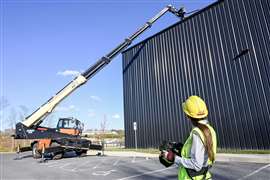Read this article in Français Deutsch Italiano Português Español
Blade runners: The five biggest trends shaping the scissor lift market
19 August 2025
From mega-site construction in North America to modular housing in the Netherlands, the humble scissor lift is undergoing a transformation. Strategic acquisitions, electric powertrains, and sector-specific engineering are redefining the industry, turning a standard jobsite tool into a specialised asset that mirrors the broader shifts in global manufacturing and technology. Euan Youdale finds out how.
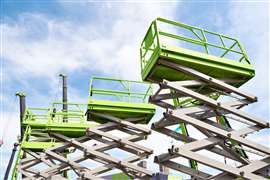 Photo: Adobe Stock
Photo: Adobe Stock
From the exhibition halls of Bauma in Munich to modular housing plants in the Netherlands, the global scissor lift market is in the midst of a major transformation. Once regarded as a generic workhorse of the construction site, it is now a focal point for the manufacturing industry’s biggest shifts.
Manufacturers are rethinking not only how and where they build their machines, but also how those machines fit into customers’ increasingly complex operational needs.
For rental companies and end-users, the scissor lift is no longer a one-size-fits-all commodity—it has become a highly specialised, strategic asset.
To make sense of it all, we look at the five biggest trends shaping the scissor lift market - regionalisation of supply chains, electrification, sector-specific design, hybridised technology and the blurring of boundaries between indoor and outdoor equipment.
1. Consolidation in manufacturing
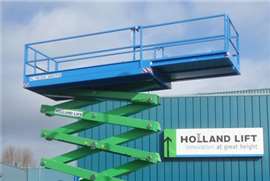
Mergers and acquisitions are reshaping the competitive landscape as companies seek greater regional presence, broader product portfolios and manufacturing efficiencies.
At Bauma, China’s Sinoboom announced the acquisition of Holland Lift, a Dutch brand long known for its large-capacity scissor lifts. The move, part of Sinoboom’s “Made in Europe for Europe” strategy, returns more than 30 heavy-duty models to the market.
“This milestone supports our long-term objectives of product diversification and deepening our European presence,” said Susan Xu, chief executive of Sinoboom Group. “The Holland Lift brand is recognised globally and has been a leader in the large scissor lift sector. Its integration will enhance our global offerings.”
Holland Lift had entered liquidation in 2023 after a “perfect storm” of economic pressures, including steel price spikes, pandemic-era supply chain disruption and intensifying competition from low-cost entrants. With Sinoboom’s backing, its range—capable of working heights up to 34 metres and capacities over 1,000kg—will be revived.
Turkish manufacturer ASKO has also been on the acquisition trail, buying both ELS and US-based Custom Equipment. In the US, the Hy-Brid Lifts brand has been rebranded as AXCS Equipment, consolidating lightweight scissor lifts under a unified line aimed at both North American and European markets.
2. Electrification
Environmental regulation, urban emissions restrictions and the economics of lower-maintenance equipment are driving a rapid shift to electric powertrains. Once a marginal option, electrification is now a defining battleground.
LGMG’s Dickey Bennett and Troy Garland highlight the key advantages: “Eco-friendly operation, quieter performance and versatility.” Genie’s Christian Dube reports “greater interest in dual fuel machines, similar to what we’ve seen in hybrid boom lifts” as rental companies seek maximum fleet utilisation across different environments.
JLG’s Bob Begley points to urbanisation as a powerful driver. “Urbanisation continues to drive the trend for higher lifting capacity models,” he said. “Customers want to bring more materials and people to the work area, within increasingly narrow building footprints.”
Yet diesel retains a foothold. Haulotte’s Paul Jensen argues that internal combustion engines still have a place in high-duty or remote applications: “Internal combustion engines are quick to refuel and reliable enough to work as hard as the operators.”
3. Sector-specific design
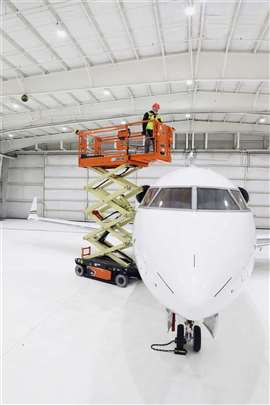 The JLG ES2646 with the new Aviation Package. (Photo: JLG).
The JLG ES2646 with the new Aviation Package. (Photo: JLG).
The scissor lift is increasingly being tailored to the needs of specific industries. Aerospace, modular housing and high-density warehousing are prompting new design approaches.
JLG’s “Aviation Package” for its ES2646 electric-drive model integrates ultrasonic and LIDAR sensors to enable contact-free aircraft maintenance. “The ES2646 with Aviation Package represents a significant advancement in aerial work platform safety for the aviation industry,” said Begley.
In the Netherlands, Omega has partnered with builder Bam to integrate fully electric crawler-mounted scissor lifts into offsite modular housing production in the Netherlands. The 615TSE and 815TSE models, with 1,500kg lift capacities, are central to Bam’s ‘Flow’ concept homes. Their lithium powertrains and adjustable platforms allow for precision assembly on factory floors.
Even mainstream product updates are being designed with end-user sectors in mind. Manitou’s new SE 1932 and SE 2632 battery-powered models, launched at the ARA Show in Las Vegas, target both indoor and outdoor tasks. “We know these machines are all about providing improved access, so we have designed them to really optimise the ability to get near and into the places they need to work,” said Brian Rabe, product marketing manager.
4. Hybridised technology
For many job sites, a single power source is no longer sufficient. Hybrid technology—combining diesel and electric—has emerged as a practical solution for equipment that must work both indoors and outdoors, or in environments where charging infrastructure is patchy.
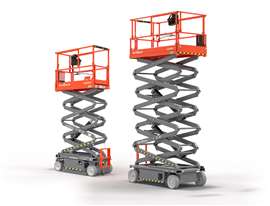 Skyjack’s E-Drive SJ3219E and SJ4740E models. (Photo: Skyjack).
Skyjack’s E-Drive SJ3219E and SJ4740E models. (Photo: Skyjack).
Genie’s Dube notes that in the 40ft class, rough terrain scissor lifts are often used outdoors for cladding or siding, but also indoors for pipe installation. Dual fuel capability allows the same machine to meet both requirements.
Skyjack’s E-Drive models, including the SJ3219 E and SJ4740 E, reflect the push for higher efficiency in electric mode. Designed to optimise runtime, power and torque, the range promises productivity gains of up to 20 per cent per charge.
Hybrid designs are not just about power—they are about extending machine versatility and increasing utilisation rates for rental fleets. As Begley puts it: “Customers are looking for lifts that can run a full work shift without needing to stop to recharge… the big gap in the electrification ecosystem is the charging infrastructure, which is why there continues to be a need for engine-powered RT scissor lifts.”
5. The blurring of indoor and outdoor equipment use
One of the most striking changes in the market is the migration of rough terrain (RT) models from purely outdoor construction sites into warehouses, logistics hubs and data centres.
“There have been significant changes in the MEWP industry, RT scissors included, over the last several years,” said Skyjack’s Malcolm Early. “These shifts have been primarily driven by safety regulations, sustainability demands and technological advancements.”
Traditionally, RT scissors—with their large platforms and high weight capacities—were the preserve of rugged outdoor work. Now, their stability and capacity make them a “project site multi-tool”, in Haulotte’s Jensen’s words, capable of handling heavy materials indoors at height.
Manufacturers have responded by introducing electric RT models and hybrids that can handle uneven terrain without the noise or emissions of diesel. Jensen notes that electric units can start and finish a job in the same location, reducing the need for machine transport mid-project and extending rental periods.
LGMG’s Bennett and Garland say the demand for RT models is sustained by large-scale warehouse and mega-site builds, particularly in North America. Early sees their continued utility across job sites of all types, while Jensen stresses their growing indoor adoption as operators become familiar with the benefits.
STAY CONNECTED



Receive the information you need when you need it through our world-leading magazines, newsletters and daily briefings.
CONNECT WITH THE TEAM











